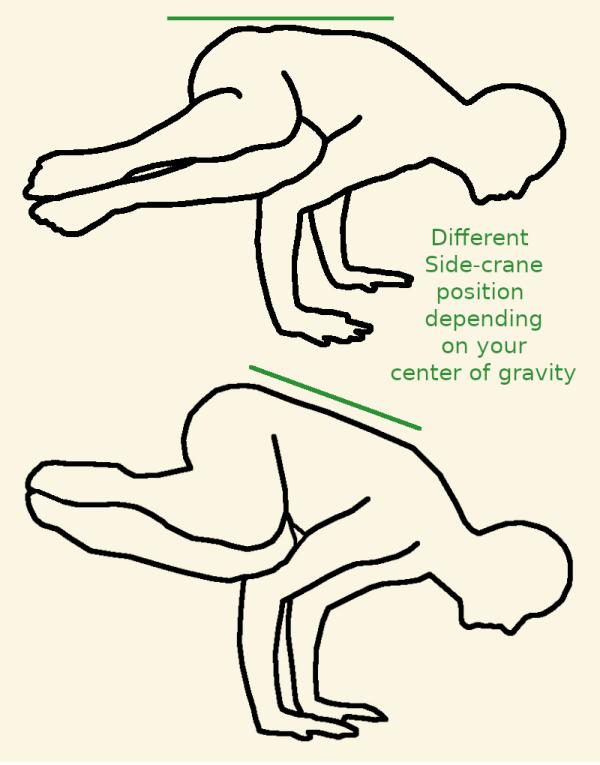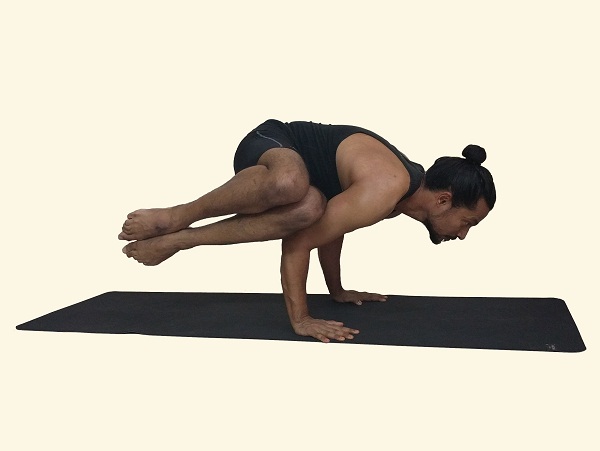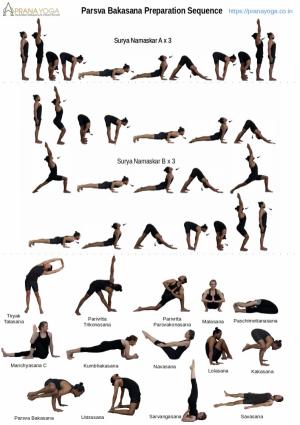Prasva – side, Bak – crane, asana – posture. The side crane posture.
This is an intermediate-level arm balancing posture that requires a mixture of strength and flexibility. Twisting flexibility is required to be able to place the thigh on the opposite upper arm, you will also need to be able to do a deep squat.
If you are already quite strong compared to your flexibility and are finding this pose difficult, focus on twisting and squatting poses like mal-asana and marichyasana C. If however you are flexible enough to manage the twisting and squatting but are not strong enough to hold yourself up, then you should focus more on developing the core strength, forearm strength, and the shoulder strength.
For a lot of arm balancing postures, we rely on gravity and shift our body weight in such a way that the weight to the front balances the weight on the back (like a weighing scale).
**Read about proper hand placement and alignment for arm balancing postures to keep your wrists safe and injury-free.
Why can’t I balance in parsva bakasana?
Our ability to do certain postures will be influenced by our unique body structure. Some people have longer legs and some others might have a longer torso. Males generally have a heavier upper body (the V-shape) and females might have a heavier lower body. So to balance your body, you may need a slightly different position from the person next to you. Once you understand the pose you can start to work with your body rather than fight the frustration.
People with a heavier lower body need to focus on bringing their hips a bit higher so that more weight will shift forward. For people with a heavy upper body, the side crane/crow would look more or less flat (shoulders and hips both on the same level)
You can see in the sketch below how this might differ for different people.

So if you feel frustrated as if it’s impossible to balance in this posture, or even that there is no way to bring the weight off the feet. Try to lift the hips up first and then lean the weight forwards onto the arms and try to balance. Remember to put a pillow or cushion in front to avoid face planting the floor.
Preparation for this posture might also help. If you are making a sequence to include this posture for yourself or your students the following guideline might help.
- Warm-up – (you can use some joint rotations- this can be focussed more on wrists arms and shoulders followed by some sun salutations)
- Flexibility – Prepare the hips for the pose. This can include deep squats (if you can work on the deep squats with both feet together then it’s even better) followed by some postures which twist the body eg. parivrtta trikon-asana, marichyasana c, etc
- Strength – Here the core power is also required so doing some postures which fire up the core and makes them a bit tight will help (but not too much, you don’t want to tire them to failure before even attempting the posture) eg plank, navasana, lift ups.
- Arm balance – You can add the crow posture here to get a feel of the arm balance, followed by the side crane/crow.
- A counter back-bending pose to release the tension from the core.
- Inversion
- Relaxation
Here is a sample sequence that you can try, that might make this pose come a little quicker. It’s alright if you can’t do it straight away, the practice journey will make it possible.
Download PDF version of the Sequence
Steps
- Squat down with your feet together.
- Exhaling, twist your torso to the right and place the left outer thigh on the right upper arm and place the palms on the ground about shoulder-width apart with the fingers wide apart. Try to bring the left outer thigh as close as possible to the right armpit.
- Maintaining a tight lock between the left upper thigh and the upper arm (keep your elbow a little bent) lift your hips slightly up and lean forward shifting more weight on the right hand. A point will come when all the weight will be shifted from your feet to the hands, at this point the feet will come off the ground and you will be balancing completely on the arms.
- Lift your chest and head, and look forward. Breathe evenly and naturally. Hold the pose for a few breaths then lower your feet back to the floor with an exhale. Repeat it on the other side for the same length of time.

The next level would be to try to straighten your arm completely (this is more difficult and might take some time to achieve).
Benefits
- Improves sense of balance
- Strengthens the arms, wrist, shoulder, and core.
- Creates a balance of strength and flexibility (YIN and YANG)
Precautions/ Contraindications
- Lower back injury
- Wrist injury
Looking for more arm balancing postures? Check our arm-balancing library.
